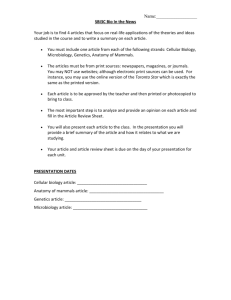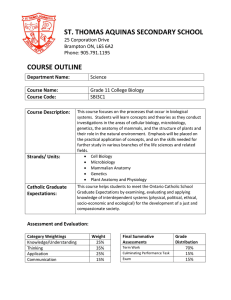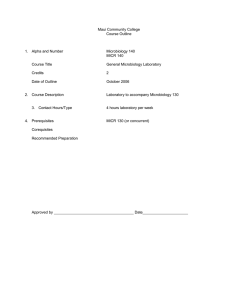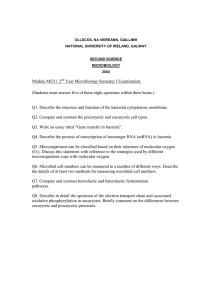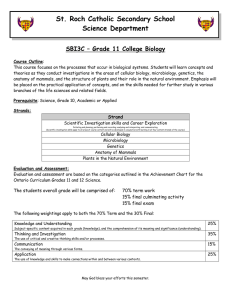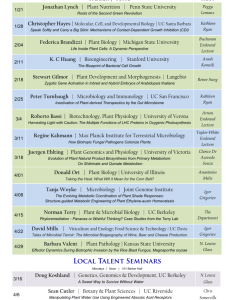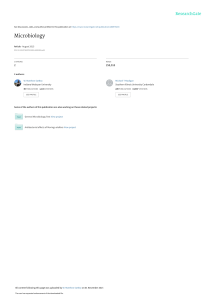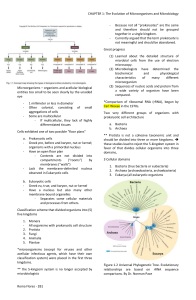SP07 Modify
advertisement
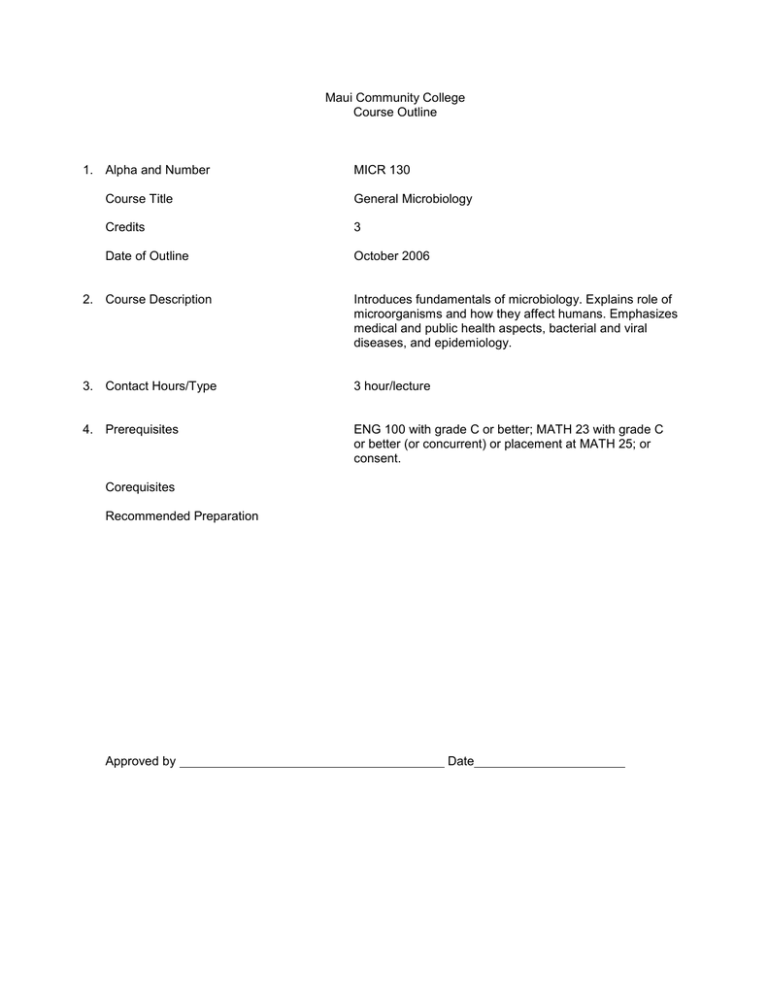
Maui Community College Course Outline 1. Alpha and Number MICR 130 Course Title General Microbiology Credits 3 Date of Outline October 2006 2. Course Description Introduces fundamentals of microbiology. Explains role of microorganisms and how they affect humans. Emphasizes medical and public health aspects, bacterial and viral diseases, and epidemiology. 3. Contact Hours/Type 3 hour/lecture 4. Prerequisites ENG 100 with grade C or better; MATH 23 with grade C or better (or concurrent) or placement at MATH 25; or consent. Corequisites Recommended Preparation Approved by Date 5. General Course Objectives: The student will learn how various microorganisms interact in nature with various other living organisms including humans. This includes a detailed study of the various types of microbes including viruses, bacteria, algae, fungi and protozoa. The various structures or the organisms, their metabolism, saprophytic and parasitic relationships, genetics, growth, survival, and death are emphasized. Methods of identification, prevention of infection, and control of diseases are included. 6. Student Learning Outcomes For assessment purposes, these are linked to #7. Recommended Course Content. On successful completion of this course, students will be able to: a. differentiate between prokaryotic and eukaryotic organisms; b. explain the basic biology of prokaryotic organisms, including cell structure, physiology, biochemistry, and genetics; c. explain how the basic biology of prokaryotes is used to classify bacteria; d. differentiate between viruses, bacteria, fungi, protozoa, and prions; e. explain the science behind antibiotic and antiseptic action and resistance in bacteria; f. describe the basic biology behind the human immune system and how microorganisms interact with the immune system; g. apply critical thinking skills to analyze data relating to issues in microbiology. 7. Recommended Course Content and Approximate Time Spent on Each Topic Linked to #6. Student Learning Outcomes. 1 week: Introduction, history of microbiology 2-3 weeks: Microscopy, cell structure (a,b,c,d,g) 2-3 weeks: Microbial growth, control of microbial growth, classification of microorganisms (a,b,c,d) 1 week: Review of basic chemistry and its applications to living organisms (b,c,d,g) 1 week: Cell biology (a,b,c,d,g) 2-3 weeks: Microbial metabolism and genetics (a,b,c,d,g) 1-2 weeks: Applications of genetics and molecular biology to microbiology and medicine (a,b,c,d,g) 1-2 weeks: Fungi, algae, protozoa and viruses – focus on medically important phyla (a,c,d,g) 1-2 weeks: Antibiotics and antiseptics: where they come from, how they work, new sources (a,b,c,d,e,g) 1 week: Epidemiology, mechanisms of pathogenicity (a,b,c,d,g) 1-2 weeks: Human immune system and applications of immunology (a,b,c,d,f,g) 8. Text and Materials, Reference Materials, Auxiliary Materials and Content Appropriate text(s) and materials will be chosen at the time the course is offered from those currently available in the field. 9. Recommended Course Requirements and Evaluation Specific course requirements are at the discretion of the instructor at the time the course is being offered. Suggested requirements might include, but are not limited to: 10-50% midterm exams 10-50% final exam 10-50% text and journal reading assignments 0-50% projects 0-10% reports on current issues and events in microbiology One or more midterm examinations and a final examination will be given. These tests may include any of the following type of questions: multiple choice, true-false, matching, short answer, short essay, fill in the blanks, and critical thinking. Exams will cover material from lecture, videos, guest speakers and reading assignments. Scheduled and unscheduled quizzes may be given. Other assignments that contribute to the grade may include any of the problem sets, essays, presentations, discussions, web searches, reports and critiques, video programs, and service learning. 10. Instructional methods will vary considerably with instructors. Specific methods will be at the discretion of the instructor teaching the course and might include, but are not limited to: a. b. c. d. e. f. Exams, tests, and quizzes with discussion and feedback; lectures, videos, CD-ROMs, DVDs, and on-line lessons; library and internet research; group work; reports; and reviews of current issues and events in microbiology. Assessment of Intended Student Learning Outcomes Standards MiICR MICR BIOL BIOL 130 140 151 151L Outcome 1.1 - Use writing to discover and articulate ideas. 2 2 3 1 Outcome 1.2 - Identify and analyze the audience and purpose for any intended communication. 1 1 2 1 Outcome 1.3 - Choose language, style, and organization appropriate to particular purposes and audiences. 1 1 3 1 Outcome 1.4 - Gather information and document sources appropriately. 2 2 3 2 Outcome 1.5 - Express a main idea as a thesis, hypothesis, or other appropriate statement. 2 2 3 2 Outcome 1.6 - Develop a main idea clearly and concisely with appropriate content. 2 2 3 2 Outcome 1.7 - Demonstrate a mastery of the conventions of writing, including grammar, spelling, and mechanics. 2 2 2 1 Outcome 1.8 - Demonstrate proficiency in revision and editing. 0 1 2 0 Outcome 1.9 - Develop a personal voice in written communication. 0 1 1 0 Outcome 2.1 - Apply numeric, graphic, and symbolic skills and other forms of quantitative reasoning accurately and appropriately. 2 3 2 2 Outcome 2.2 - Demonstrate mastery of mathematical concepts, skills, and applications, using technology when appropriate. 1 2 1 2 Outcome 2.3 - Communicate clearly and concisely the methods and results of quantitative problem solving. 2 2 2 2 Standard 1 - Written Communication Standard 2 - Quantitative Reasoning Outcome 2.4 - Formulate and test hypotheses using numerical experimentation. 1 1 1 2 Outcome 2.5 - Define quantitative issues and problems, gather relevant information, analyze that information, and present results. 1 2 1 2 Outcome 2.6 - Assess the validity of statistical conclusions. 1 1 2 2 Outcome 3.1 - Use print and electronic information technology ethically and responsibly. 2 2 2 1 Outcome 3.2 - Demonstrate knowledge of basic vocabulary, concepts, and operations of information retrieval and technology. 1 1 2 1 Outcome 3.3 - Recognize, identify, and define an information need. 1 1 2 1 Outcome 3.4 - Access and retrieve information through print and electronic media, evaluating the accuracy and authenticity of that information. 1 1 3 2 Outcome 3.5 - Create, manage, organize, and communicate information through electronic media. 1 1 2 2 Outcome 3.6 - Recognize changing technologies and make informed choices about their appropriateness and use. 2 1 3 1 Outcome 4.1 - Identify and analyze the audience and purpose of any intended communication. 1 1 1 0 Outcome 4.2 - Gather, evaluate, select, and organize information for the communication. 1 1 1 0 Outcome 4.3 - Use language, techniques, and strategies appropriate to the audience and occasion. 1 1 1 0 Outcome 4.4 - Speak clearly and confidently, using the voice, volume, tone, and articulation appropriate to the audience and occasion. 1 1 1 0 Standard 3 - Information Retrieval and Technology Standard 4 - Oral Communication Outcome 4.5 - Summarize, analyze, and evaluate oral communications and ask coherent questions as needed. 1 1 1 0 Outcome 4.6 - Use competent oral expression to initiate and sustain discussions. 2 1 2 1 Outcome 5.1 - Identify and state problems, issues, arguments, and questions contained in a body of information. 2 2 2 2 Outcome 5.2 - Identify and analyze assumptions and underlying points of view relating to an issue or problem. 2 2 2 2 Outcome 5.3 - Formulate research questions that require descriptive and explanatory analyses. 2 3 2 2 Outcome 5.4 - Recognize and understand multiple modes of inquiry, including investigative methods based on observation and analysis. 2 2 1 2 Outcome 5.5 - Evaluate a problem, distinguishing between relevant and irrelevant facts, opinions, assumptions, issues, values, and biases through the use of appropriate evidence. 1 2 2 2 Outcome 5.6 - Apply problem-solving techniques and skills, including the rules of logic and logical sequence. 2 3 2 2 Outcome 5.7 - Synthesize information from various sources, drawing appropriate conclusions. 2 2 2 2 Outcome 5.8 - Communicate clearly and concisely the methods and results of logical reasonong. 2 2 2 2 Outcome 5.9 - Reflect upon and evaluate their thought processes, value system, and world views in comparison to those of others. 0 1 1 1 Standard 5 - Critical Thinking
